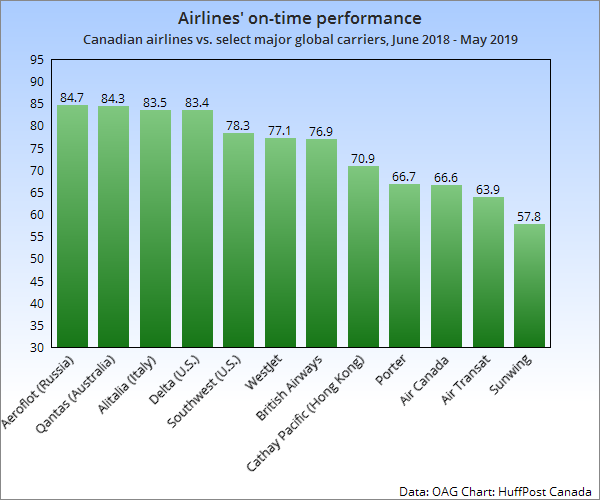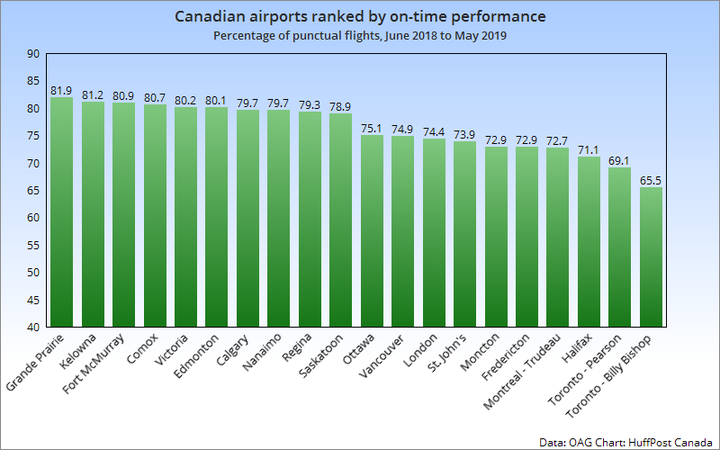This story is the first of HuffPost Canada’s UNFRIENDLY SKIES, a three-part series that looks at the impact of rapid airline industry changes on Canadian passengers.

MONTREAL ― Canadian airports and airlines are some of the worst performers worldwide when it comes to flight delays, and new federal rules that allow passengers to be stuck on the tarmac for longer could make things worse.
All but one of Canada’s major airlines rank in the bottom half for on-time performance in a new survey from travel data provider OAG.
Canada’s best performer, WestJet, ranks 57th out of 125 airlines surveyed, with 77.1 per cent of all flights arriving on time. The country’s worst performer, Sunwing, ranks as the second-worst airline in the world, 124th out of 125, with only 57.8 per cent of flights on time.
Sunwing experienced numerous flight glitches in recent years, including major delays in Toronto and Montreal in April, 2018, that led to a fine from the Canadian Transportation Agency.

Looking at airports, Canada doesn’t fare much better. Our best airport, in Grande Prairie, Alta., ranks 108th out of 505 airports surveyed.
Toronto’s two commercial passenger airports, Pearson and Billy Bishop, rank as the two worst airports in Canada and among the worst in the world ― 475th and 489th, respectively.
Interestingly, there is a yawning east-west divide, with western Canadian airports performing better than others.

The survey comes as Canada is about to launch a new “passengers’ bill of rights” that some critics say will make it easier for airlines to delay flights.
Under the new regulations, airlines will be able to keep passengers stuck on the tarmac for up to three hours, plus an additional 45 minutes if the airline believes takeoff is imminent.
Currently, Canada has no government-set limits on tarmac delays, but airlines themselves had standards built into their tariffs. The industry standard was 90 minutes, which is also what a Senate committee recommended be the rule in the new passenger bill of rights. The government rejected that recommendation.
Airlines themselves have been pushing for longer tarmac delays. Air Canada extended its maximum tarmac time to four hours in 2018.
Additionally, it will be very difficult to get compensation from airlines in most cases where flights are delayed or passengers are denied boarding, said Gabor Lukacs, a prominent consumer advocate who has challenged airline practices in courts.
Watch: Here are the budget airlines in Canada. Story continues below.
Lukacs said he worries about the possibility of longer delays under the new rules because “when something becomes legal, they will do it. On the other hand, the counterargument is it’s in the airline’s best interest to get passengers to their destination as quickly as possible.”
Lukacs’ advocacy group, Air Passenger Rights, has accused the government of letting the airline industry dictate the new passengers’ bill of rights.
A spokesperson for Transport Minister Marc Garneau said the tarmac delay rule was decided “based on operational realities and international best practices. For example, in the United States, air carriers are required to offer the option to disembark after a three hour delay on domestic flights, and a four hour delay on international flights.”
While airlines frequently blame weather for flight delays, data from the U.S. federal government shows that extreme weather events are responsible for fewer than 5 per cent of flight delays in the U.S. The most common reason for delays was late-arriving aircraft, meaning flights delayed because earlier flights were delayed. This accounted for nearly 42 per cent of U.S. delays. Canada does not currently keep track of this type of data.
But Lukacs points out that Canada has much harsher weather than most of the U.S., so it may not be a fair comparison. And Toronto’s worst-in-the-country Billy Bishop Airport has unique issues to deal with because it’s on an island.
“This may be an apples to oranges comparison,” he told HuffPost Canada by phone.
Nonetheless, Canada’s poor weather doesn’t explain why Alaska Airlines has a higher on-time percentage than any Canadian airline (80.7 per cent) and is the third best among U.S. airlines.
Lukacs argues these on-time rankings are incomplete: There isn’t enough data to determine, for instance, whether it’s a particular airport or a particular airline that’s behind delays in a given place.
Either way, airlines should be taking bad weather into account when planning their schedules, Lukacs said.
“If airlines and airports ignore the weather realities, then you have guaranteed, built-in failure,” he said.